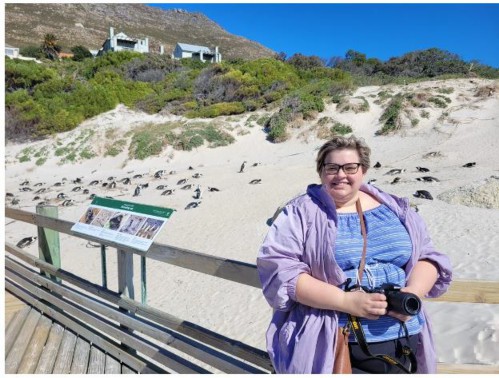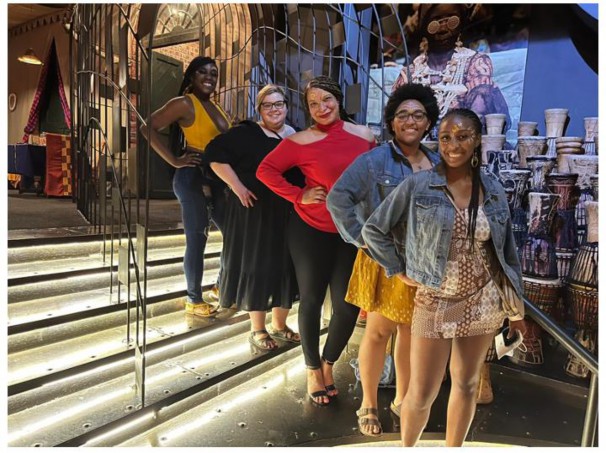Joelle Smith, M.S. Doctoral Student
University of Missouri- Columbia
After completing my master’s in Human Development and Family Studies at Auburn University in 2019, I was awarded the opportunity to complete my doctorate at the University of Missouri, under the mentorship of Dr. Antoinette Landor. I have recently completed my third year at the university and working with Dr. Landor has provided me with endless opportunities for growth in my research. Prior to 2020, she proposed a study titled “Perceptions of Physical Appearance in Africa: Skin tone and how it shapes dating and health of young adults at the University of Western Cape,” which would study physical appearance concerns around skin tone and colorism, and their impact on perceptions of romantic relationships. Dr. Landor was meant to travel to Cape Town during the summer of 2020, but due to Covid-19 restrictions, she was not able to complete this trip until the Spring of 2022. Due to the time delay, Dr. Landor was able to assist myself, two other graduate students, and one undergraduate student with obtaining funding to travel with her and assist in data collection. Receiving the Henry Mitchell Scholarship allowed us to travel to Cape town for two weeks in early Spring of 2022, and to conduct our own supplemental research projects examining skin tone. My own research focused on skin tone preferences in interracial romantic relationships.
Prior to this trip, I had only traveled within the continental United States, and this travel was minimal. Because of this, I had a lot of fear about the flying and international customs and airports. We left on a Sunday evening and spent 36 hours traveling, of which, 17 were spent on an airplane. We had two layovers, one in Dallas, Texas, and one in Doha, Qatar. The travel itself was not difficult, but was very tiring, as I did not sleep well on the plane. We arrived in Cape Town late morning, Tuesday, March 29th, and were picked up at the airport by Mark, who provided our rental car and helped to transport our luggage to the house we were staying in.
Leaving the airport, one of the first things I saw was a township. The townships are predominantly Black neighborhoods, a result of forced relocation during apartheid. The small homes are mostly made of what appears to be recycled wood and scrap metal. It was apparent
that trash collection didn’t occur in this neighborhood, as there was trash all along the edge of the roads, as well as goats and stray dogs. As someone who grew up in middle class neighborhoods and had not traveled, this was really jarring for me. I was expecting the area to be more suburban, as I knew that Cape Town was a relatively wealthy city. It was my first true glimpse at true income inequality and lack of government aid for people in need.

Image: A township that we drove by often.
Our first few days in South Africa were spent in a small tourist/resort town called Saldanha, which is on the western coast about an hour north of Cape Town. There, we met with researchers from the University of Western Cape, along with community leaders from the surrounding area. We attended a meeting where they discussed their plans for the community and the research they were planning to conduct. Unfortunately, I fell sick while we were in Saldanha and was sick for several days, so I did miss out on some of the planning meetings for our own research and a day of sightseeing in the surrounding area.
Following our stay in Saldanha, we returned to our primary residence, which was a three-bedroom townhouse in the heart of Cape Town, near the Waterfront. This area is primarily middle to upper class and white. It became very apparent in our time spent in this area that the white people were the consumers, while Black and coloured (mixed race) individuals served them. The grocery store and restaurants near our residence were primarily staffed with Black individuals. As a white person and an American, I experienced many of the same privileges there that I experience at home. Due to this, it was clear the lasting impact that British and Dutch colonialization had had on Cape Town, as well as the lasting affects of Apartheid. I imagined that Cape Town was similar to an American city because of the shared history of colonialization. This was further cemented by the reality of the townships. As the area we were in was upper class and white, while the townships were predominantly coloured or Black and low income, it highlighted who held the wealth in Cape Town, and I imagine in South Africa in general.
Following our first week, we were able to begin working on campus at the University of Western Cape (UWC), which is similar to an American historically Black institution, in that it was created when the main university in Cape Town barred admittance to any non-white persons. The campus at UWC is a mixed of older, more dated buildings, and newer construction. We were provided an office space in one of the older buildings, and it was unique in that there were bars on all of the windows and interior doors, highlighting a fear of heightened crime in the area.
Image: bars on a classroom door at the University of Western Cape
For our research, we spent three days recruiting and interviewing 75 UWC students, in focus groups ranging from two to 15 people. We asked the students questions about differential treatment based on skin tone in South Africa, their racial identity, romantic relationships, and skin bleaching products. The participants appeared excited to talk to us about their experiences, often talking to or over each other to get their points across. We had many students inform us that they had discussed the realities of skin tone preferences with other students before attending the focus group and talking to us, illustrating the importance of the conversations and the participants desire to talk and share their experiences. Several themes emerged in their answers. First, segregation had culturally distanced coloured and Black South Africans, so that they did not feel that they shared similar experiences or beliefs. Often, the privileges awarded to coloured individuals were discussed. Second, overall, lighter skin, silkier hair, and more euro-centric features, especially for woman, was a type of social capital, allowing the individual to gain privileges in the job and marriage market. Finally, many participants knew of someone who had used skin lightening products and the adverse reactions to their products, such as rashes, discoloration, or even open wounds, were discussed. Comparing this to our lab’s research in the United States, it was clear that South Africans experienced similar discrimination based on skin color in their every day lives, but that these skin tone biases were also based in the history of Apartheid and inequality that is still prevalent today.
Following the completion of the focus groups, we were able to spend our last few days enjoying some of the South African food and scenery. We celebrated the completion with a nice dinner at a local restaurant in Cape Town, set in a historic Victorian home with a gorgeous courtyard. I was able to try ostrich meat for the first time, which was an interesting experience. For our final Saturday in Cape Town, we took a bus tour to the Cape of Good Hope. As part of this tour, I was able to fulfill one of my bucket-list items when we saw penguins nesting on Boulder Beach. Penguins are my favorite animal so seeing them in nature was really moving. We also were able to walk along the beach and take pictures at the Cape of Good Hope, which is the most beautiful location I have ever been to. I felt a lot of peace there and it was a wonderful way to end the trip. I would like to take this moment to thank the Henry Mitchell scholarship for funding such an amazing, life changing experience. Through their contributions towards my travel and accommodations, I was able to travel internationally for the first time, fulfil a bucket-list item, and conduct research not often afforded to graduate students. I would also like to thank Dr. Landor for the opportunity and guidance that allowed me to gain this valuable experience.
Lastly, I would like to thank Dr. Rodney Uphoff for coordinating the trip and providing valuable information on travel to Cape Town.
Images:
The sign at the Cape of Good Hope

The courtyard at the restaurant where we celebrated the completion of our focus groups.

Visiting the penguins at Boulder Beach.

Our research group out to dinner and a show based around traditional African food, music, and dance.
Reviewed 2025-11-06